My father loved the natural world, especially when it came to finding good things to eat. In a family of six living on his railroader's salary, wild harvests were welcome additions to the family table. Beyond fish caught and game shot, fungi, plants, nuts, and fruits provided more reasons to get outdoors in every season.Spring was for morels in the woods, followed by wild asparagus along roadsides, fencerows, and field edges. Early July was for "black caps," as Dad called black raspberries. Fall was for walnuts and hickory nuts.But my favorite gathering season was wild plum time. With some scouting and planning, you can find and harvest your own wild plum bounty. Wild fruits may be gathered in Minnesota state forests, state parks, wildlife management areas, and on some other public lands. Check with the land manager to make sure it's allowed before you gather.Look for wild plum thickets in spring, when the profuse white mounds of blossoms form before leaf-out and give away locations. Each flower features five elegant white petals with a clump of delicate, yellow-tipped stamens bursting from the middle. Some wild plum blossoms feature red sepals, which can give flowers a pink tinge close up. Flowers clump at the ends of branches.It's easy to spot fruiting trees at plum time, too, which occurs from late August to mid-September in Minnesota. Dress in long-sleeved pants and shirts to protect against thorns, poison ivy, and any wild parsnip you may encounter. A bucket or mesh sack holds your harvest as you work from tree to tree and thicket to thicket.It's easy to glean the edge of a wild plum patch. But much plum bounty comes when you ease into a thicket. Either way, the perfect plums are the ones still on the branch but that fall off at a gentle touch. Ripe plums already on the ground can be good if they are very freshly fallen, before they start decaying and getting mushy.Back home, wash the fruits and go to work processing them into wild plum creations within a day or two. Don't refrigerate wild plums, as the chill will make them mealy.
With some scouting and planning, you can find and harvest your own wild plum bounty. Wild fruits may be gathered in Minnesota state forests, state parks, wildlife management areas, and on some other public lands. Check with the land manager to make sure it's allowed before you gather.Look for wild plum thickets in spring, when the profuse white mounds of blossoms form before leaf-out and give away locations. Each flower features five elegant white petals with a clump of delicate, yellow-tipped stamens bursting from the middle. Some wild plum blossoms feature red sepals, which can give flowers a pink tinge close up. Flowers clump at the ends of branches.It's easy to spot fruiting trees at plum time, too, which occurs from late August to mid-September in Minnesota. Dress in long-sleeved pants and shirts to protect against thorns, poison ivy, and any wild parsnip you may encounter. A bucket or mesh sack holds your harvest as you work from tree to tree and thicket to thicket.It's easy to glean the edge of a wild plum patch. But much plum bounty comes when you ease into a thicket. Either way, the perfect plums are the ones still on the branch but that fall off at a gentle touch. Ripe plums already on the ground can be good if they are very freshly fallen, before they start decaying and getting mushy.Back home, wash the fruits and go to work processing them into wild plum creations within a day or two. Don't refrigerate wild plums, as the chill will make them mealy.
 Wild Plum Jam
Wild Plum Jam
5 cups pitted, chopped wild plums
1 cup water
6 cups sugar
1 teaspoon lemon juice
2 (1.75-ounce) packages fruit pectin
8 half-pint (or 4 one-pint) canning jars with lidsBring plums and water to boil in a large pot. Reduce heat, stir in sugar, increase heat, and bring mixture back to a full boil. Add lemon juice to prevent foaming. Immediately mix in pectin, stirring for 1 minute. Remove pot from heat and let mixture cool. Sterilize jars in boiling water. Pack jars with plum mixture to within ¼ inch of top. Top jars with lids and rings. Fill a pot half full of water and bring to a boil. Place jars in boiling water and boil for 10 minutes. Remove jars with tongs; cool on a towel on the countertop. Notes: Follow standard safe canning procedures. Increase sugar for sweeter jam; decrease sugar for tarter flavor. Try flavoring your jam with cinnamon, nutmeg, ginger, or orange peel.Wild Plum Sauce
Bring 2 cups of water and 2 cups of sugar to a boil, then keep stirring for 5 minutes. Add a pound of pitted skin-on wild plums and simmer for 10 to 12 minutes. Cool and freeze in plastic containers. Expand recipe as needed for bigger batches. Dried Plums
Take the pits out or leave them in and dry in a food dehydrator. The natural sugars will intensify. Ya, it's a prune!Part of the attraction was the weather. In Minnesota, wild plums ripen during that bridge time when the days bask in summerlike warmth but the nights cool off with a hint of autumn, spurring the fruits to set their sugars and color up to reds, yellows, and purple-blues. The sun takes on the orange glow of a new autumn, but the air feels like old summer—thick and moist and full.Sometimes we'd locate a thicket on a fall deer hunt or a winter rabbit hunt, noting its location for next plum season. Scouting locations was easier in spring. A plum thicket's mound of white blossoms beckoned us for a return visit in four months' time when the foliage was green and jungle-like, the plums plump and ripe.The other part of the attraction was the bounty itself. I still love that burst of sweet-tart flavor that fills my mouth when I bite into a fresh wild plum that has plopped off the branch at my touch. In a good plum year, we'd bring our harvest home by the bucketful and go to work making jam with Mom.The first step was dumping the plums into cool water in the kitchen sink to wash and sort. We'd throw out the mushy specimens and set the hardest ones aside to ripen.Mom would simmer the prime plums in a syrup boiled from water and cane sugar. She'd include a few hard plums to add extra tartness. The resulting mash was then strained of pits and skins, and the remaining extrusion of plum meats and juice served as the basis for a year's supply of wild plum jam.I have since expanded my wild plum repertoire to plum sauce, dried plums, and plum wine. And I have grown in my appreciation of this native plant's importance to wildlife, to the American Indians who used it for food and medicine, and to the early Minnesota pioneers who found wild plums abundant on the landscape.
Article continues below sidebar
Pick and Prepare Plums
 With some scouting and planning, you can find and harvest your own wild plum bounty. Wild fruits may be gathered in Minnesota state forests, state parks, wildlife management areas, and on some other public lands. Check with the land manager to make sure it's allowed before you gather.Look for wild plum thickets in spring, when the profuse white mounds of blossoms form before leaf-out and give away locations. Each flower features five elegant white petals with a clump of delicate, yellow-tipped stamens bursting from the middle. Some wild plum blossoms feature red sepals, which can give flowers a pink tinge close up. Flowers clump at the ends of branches.It's easy to spot fruiting trees at plum time, too, which occurs from late August to mid-September in Minnesota. Dress in long-sleeved pants and shirts to protect against thorns, poison ivy, and any wild parsnip you may encounter. A bucket or mesh sack holds your harvest as you work from tree to tree and thicket to thicket.It's easy to glean the edge of a wild plum patch. But much plum bounty comes when you ease into a thicket. Either way, the perfect plums are the ones still on the branch but that fall off at a gentle touch. Ripe plums already on the ground can be good if they are very freshly fallen, before they start decaying and getting mushy.Back home, wash the fruits and go to work processing them into wild plum creations within a day or two. Don't refrigerate wild plums, as the chill will make them mealy.
With some scouting and planning, you can find and harvest your own wild plum bounty. Wild fruits may be gathered in Minnesota state forests, state parks, wildlife management areas, and on some other public lands. Check with the land manager to make sure it's allowed before you gather.Look for wild plum thickets in spring, when the profuse white mounds of blossoms form before leaf-out and give away locations. Each flower features five elegant white petals with a clump of delicate, yellow-tipped stamens bursting from the middle. Some wild plum blossoms feature red sepals, which can give flowers a pink tinge close up. Flowers clump at the ends of branches.It's easy to spot fruiting trees at plum time, too, which occurs from late August to mid-September in Minnesota. Dress in long-sleeved pants and shirts to protect against thorns, poison ivy, and any wild parsnip you may encounter. A bucket or mesh sack holds your harvest as you work from tree to tree and thicket to thicket.It's easy to glean the edge of a wild plum patch. But much plum bounty comes when you ease into a thicket. Either way, the perfect plums are the ones still on the branch but that fall off at a gentle touch. Ripe plums already on the ground can be good if they are very freshly fallen, before they start decaying and getting mushy.Back home, wash the fruits and go to work processing them into wild plum creations within a day or two. Don't refrigerate wild plums, as the chill will make them mealy.Wild Plum Creations
 Wild Plum Jam
Wild Plum Jam5 cups pitted, chopped wild plums
1 cup water
6 cups sugar
1 teaspoon lemon juice
2 (1.75-ounce) packages fruit pectin
8 half-pint (or 4 one-pint) canning jars with lidsBring plums and water to boil in a large pot. Reduce heat, stir in sugar, increase heat, and bring mixture back to a full boil. Add lemon juice to prevent foaming. Immediately mix in pectin, stirring for 1 minute. Remove pot from heat and let mixture cool. Sterilize jars in boiling water. Pack jars with plum mixture to within ¼ inch of top. Top jars with lids and rings. Fill a pot half full of water and bring to a boil. Place jars in boiling water and boil for 10 minutes. Remove jars with tongs; cool on a towel on the countertop. Notes: Follow standard safe canning procedures. Increase sugar for sweeter jam; decrease sugar for tarter flavor. Try flavoring your jam with cinnamon, nutmeg, ginger, or orange peel.Wild Plum Sauce
Bring 2 cups of water and 2 cups of sugar to a boil, then keep stirring for 5 minutes. Add a pound of pitted skin-on wild plums and simmer for 10 to 12 minutes. Cool and freeze in plastic containers. Expand recipe as needed for bigger batches. Dried Plums
Take the pits out or leave them in and dry in a food dehydrator. The natural sugars will intensify. Ya, it's a prune!


